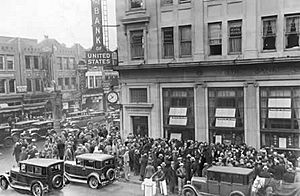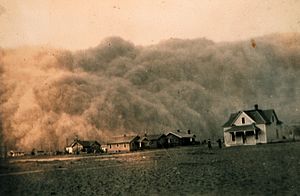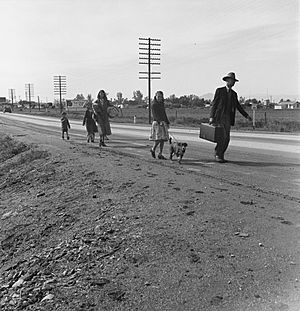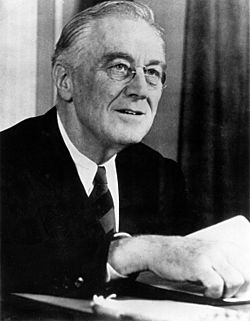Great Depression in the United States facts for kids
| 1929–1941 | |
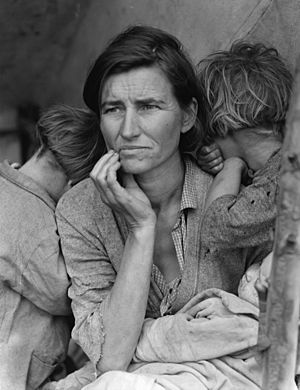
Dorothea Lange's 1936 photo Migrant Mother is an iconic photograph associated with the Great Depression
|
|
| Preceded by | Roaring Twenties |
|---|---|
| Including | Early New Deal Era First Great Migration Prohibition |
| Followed by | World War II New Deal Era |

The Great Depression was a very tough time in American history. It started in October 1929 with the stock market crash. This crash led to a decade of serious problems. Many people lost their jobs, and poverty became widespread. Businesses made very little money, and prices for goods went down. Farmers also earned much less. People lost hope in the economy and their own futures.
Many things caused the Depression. People had borrowed too much money. Banks and investors made risky loans without enough rules. Also, there weren't many new industries growing fast. All these problems made people spend less. This caused businesses to produce less, creating a difficult cycle.
Some industries suffered more than others. Building new homes and factories almost stopped. Shipping, mining, and logging also struggled. Making big items like cars and appliances was also hit hard. People simply couldn't afford to buy them. The economy was at its worst in late 1932 and early 1933. It then grew for four years, but another small downturn happened in 1937–1938.
The Depression changed American politics a lot. After three years, President Herbert Hoover was blamed for not fixing the crisis. He lost the 1932 election by a huge amount to Franklin D. Roosevelt. Roosevelt's plan to fix the economy was called the New Deal. It created many new programs to help people, restart the economy, and make changes. This made a big shift in politics, with new ideas becoming popular.
Many people moved during this time. Families from the Great Plains (called the Okies) and the South moved to places like California. Others went to cities in the North, a movement known as the Great Migration. Sadly, tensions between different racial groups also grew.
The Great Depression still teaches us important lessons. It shaped how governments deal with economic problems today. For example, governments now use stimulus packages and programs like Social Security. It also inspired famous books like John Steinbeck's The Grapes of Wrath.
Contents
Why the Depression Happened
The Stock Market Crash
The Wall Street Crash of 1929 is often seen as the start of the Great Depression. It began on October 24, 1929, and prices kept falling until March 1933. It was the longest and worst stock market crash in U.S. history.
Before 1929, stock prices were rising fast. People felt very confident and borrowed money to buy more stocks. But on October 24 (called Black Thursday), stock prices started to drop. People panicked and sold their stocks quickly, making prices fall even more. On October 29 (Black Tuesday), stock values dropped by $14 billion in just one day. That week, over $30 billion was lost. This was more than ten times the entire government budget.
Many banks had invested their customers' savings in the stock market. When the market crashed, these banks had to close. People became very scared of losing more money. They stopped buying things, which hurt businesses even more. Many investors who hoped to get rich lost everything. The stock market crash severely damaged the American economy.
Bank Failures
Many banks across the country closed during the Depression. This was a huge problem. Banks failed for several reasons. They had lent money without enough rules. People lost trust in the banks and the economy. Farmers also couldn't pay back their loans.
As these problems grew, people rushed to take their money out of banks. This meant banks didn't have enough cash. They were forced to sell off loans and assets quickly. This made the banking system collapse on a large scale. In November 1930, the first big banking crisis began. Over 800 banks closed by January 1931. By October 1931, over 2,100 banks had closed. By 1933, more than 9,000 banks had shut down.
When banks closed, millions of Americans lost their savings. About $1.36 billion was lost from people's accounts. There was no Federal Deposit Insurance Corporation (FDIC) yet to protect deposits. This meant everyday people lost their life savings. As a result, the country's total economic output (GDP) fell sharply. It took nearly four years for it to start recovering.
Too Many Banks, Too Few Rules
In the early 1900s, there were very few rules for banks. A law in 1900 made it easier to open a national bank. This led to many small banks opening, especially in farming areas. These small banks often made risky loans to farmers.
The economy grew well from 1887 to 1920. World War I especially boosted farming. This made banks and people feel very confident. So, banks became even more relaxed about lending money. There were too many banks, and they competed by offering risky loans. This caused problems with bank profits and loan quality as early as 1900.
Crop failures starting in 1921 made things worse. Areas like the Corn Belt and Cotton Belt suffered greatly, especially during the Dust Bowl era. Land values dropped. In 1921, there were about 31,000 banks. But between 1921 and 1930, 505 banks closed due to these farming problems. This was the largest banking failure on record at the time. People began to lose trust in the banking system. This lack of trust grew during the Great Depression, making the financial crisis even worse.
Spreading Panic
After the stock market crash, people lost faith in the government's economic plans. Panic began to spread. President Hoover kept the country on the Gold Standard. This meant the value of money was tied to gold. People with gold reserves worried about its future value. When Europe started moving away from the Gold Standard, Americans began taking their gold out of the country or hoarding it.
This made the market suffer even more. Rumors about bank stability spread, and people's confidence dropped. Panic caused Americans everywhere to withdraw their money all at once. This continued from 1929 to 1933, creating the biggest financial crisis in banking history. This panic turned a mild economic slowdown into a major depression.
When people demanded their money, banks didn't have enough cash. They had to sell assets quickly, often at very low prices. This caused huge losses. Healthy banks sometimes took advantage of struggling ones. This created a cycle where banks couldn't pay depositors, leading to widespread failures. People and businesses held onto their savings, fearing the future. The government tried different policies, but the lack of confidence made recovery very difficult.
Life During the Depression
One clear sign of the Depression was the rise of "Hoovervilles." These were shantytowns built by homeless people on empty lots. They were made of cardboard boxes, tents, and flimsy wooden sheds. People living there begged for food or went to soup kitchens. The name "Hooverville" was a sarcastic jab at President Herbert Hoover. Many blamed his policies for the Depression.
The government didn't track unemployment rates back then. But experts estimate that unemployment reached nearly 25% in 1933. Some put it at 22.5% in 1932. Job losses were less severe for women and workers in industries like food or clothing. Government workers and sales people also fared better. But unskilled men in cities faced very high unemployment.
Age also mattered. Young people struggled to find their first jobs. Men over 45 who lost their jobs rarely found new ones. Employers preferred younger men. Millions found work during the Depression, but many with fewer skills were stuck in long-term unemployment.
Many people who had moved to cities in the 1920s went back to rural areas. Cities had no jobs, and country relatives often had more food. City governments tried to help by starting public works projects. But tax money was disappearing, and cities couldn't handle the crisis by 1931. Private charities were also overwhelmed. People relied on cheap help like soup kitchens. After 1933, federal money helped cities, but their budgets didn't fully recover until 1941.
President Hoover and later President Roosevelt's New Deal programs used huge construction projects. They hoped to boost the economy and solve unemployment. Agencies like the CCC, FERA, WPA, and PWA built and fixed public buildings and roads. These programs created many jobs for unemployed men, especially the long-term unemployed.
The Democratic Party won elections easily in 1932, 1934, and 1936. They gained support from city dwellers, especially those with low skills, Catholics, Jews, and Black Americans. The Democrats promised and delivered political recognition, union membership, and relief jobs. City political machines became stronger. They helped families navigate the government system to get aid. Roosevelt won almost every group's vote in 1936. However, some middle-class voters turned against him after the 1937–38 recession.
In 1938, Republicans made a comeback. Roosevelt's attempts to remove political opponents failed. A group of conservative Republicans and Southern Democrats took control of Congress. They stopped the expansion of New Deal ideas. Roosevelt still won in 1940 because of strong support in the South and in cities.
When World War II began in 1940, city economies bounced back. The government invested heavily in new factories and war production. This created jobs for anyone who wanted to work. The war brought back prosperity and hope across the nation. West Coast cities like Los Angeles and Seattle saw the biggest impact.
Historians have studied how New Deal spending helped health in cities. They found that more relief spending was linked to fewer infant deaths and fewer deaths from infectious diseases.
Global Impact
The Great Depression started in the U.S. but quickly spread worldwide. It hit both rich and poor countries hard. People's incomes, spending, and factory output dropped. Taxes, profits, and prices also fell. International trade plunged by more than half. Unemployment in the U.S. reached 25%. In some countries, it was as high as 33%.
Cities around the world suffered, especially those that relied on heavy industry. Building projects almost stopped in many places. Farms and rural areas were also hit hard as crop prices fell by about 60%. Areas that depended on basic industries like farming, mining, and logging suffered the most. This was because demand for their products fell, and there were few other jobs.
Most economies started to recover by 1933–34. But in the U.S. and some other countries, the economic problems lasted until World War II began. War industries then boosted the economy and led to recovery.
There's still debate about what caused the Great Depression. Most economists at the time suggested cutting government spending and raising taxes. However, British economist John Maynard Keynes argued for large government spending to make up for low private investment. No major country fully adopted his ideas in the 1930s.
Europe
- Europe was badly affected in both rural and industrial areas. Democracy weakened in most countries.
- In Britain, there were no programs like the New Deal.
- In France, a government called the "Popular Front" tried programs to help workers. But these faced strong opposition.
- Germany had recovered and was doing well in the late 1920s. But the Depression hit hard in 1929. The political situation became violent, and the Nazi Party led by Adolf Hitler came to power. Germany's economy recovered by focusing on self-sufficiency, controlling wages and prices, and especially by increasing military spending.
- Spain was a poor farming nation. It faced growing political problems that led to the Spanish Civil War (1936–1939). The war caused huge damage. Francisco Franco's forces took control of the country in 1939.
- In Benito Mussolini's Italy, the government tightened its control over the economy. The economy never became strong.
Canada and the Caribbean
- In Canada, the economy shrank by 40% between 1929 and 1939. Unemployment reached 28%. Many businesses closed, and exports fell by half. Areas relying on farming, mining, and logging were hit hardest. Families lost most of their savings. Local governments offered some help, but there was no big national program like the New Deal.
- Canada's Prime Minister R. B. Bennett raised taxes on U.S. goods. This was a response to the American Smoot–Hawley Tariff Act of 1930. He also lowered taxes on goods from the British Empire. Even so, the Canadian economy suffered. Bennett proposed programs like the New Deal in 1935, but he lost the election that year.
- Cuba and the Caribbean faced high unemployment. This was due to fewer exports to the U.S. and falling export prices.
Asia
- Japan's economy grew fast after modernizing. Factories and mining became a big part of its economy. However, much of this growth was for building up its military. From 1937, Japan focused on a large war and occupation of China.
- China's severe depression was made worse by the Second Sino-Japanese War and internal conflicts.
Australia and New Zealand
- In Australia, governments focused on cutting spending and reducing national debt.
- In New Zealand, a new government adopted economic and social policies similar to the New Deal after the 1935 election.
Government Responses
Roosevelt's New Deal
In 1933–34, President Roosevelt launched the "First New Deal." It included many programs for farmers, banks, and the economy. Relief programs helped those who had been unemployed for a long time. The most popular program was the Civilian Conservation Corps (CCC). It put young men to work on construction jobs, especially in rural areas.
Prohibition (the ban on alcohol) was ended, which was a campaign promise. This also brought in new tax money for local and state governments. Other relief programs worked with local governments to create jobs.
The National Recovery Administration (NRA) aimed to boost demand and provide work. To stop prices from falling, the gold standard was suspended. Business leaders in each industry set rules to stop "cut-throat competition." This competition was thought to be driving down prices and profits. Some agencies from Hoover's time continued, like the Reconstruction Finance Corporation. It gave financial help to banks and railroads. New reforms also took place, like the Tennessee Valley Authority (TVA). It aimed to bring electricity and modern life to a poor, mountainous region.
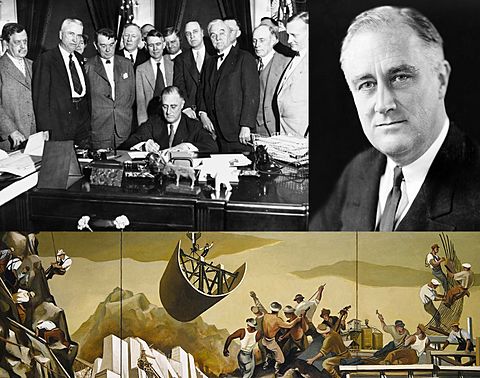
Top right: Franklin D. Roosevelt, who was responsible for initiatives and programs are collectively known as the New Deal.
Bottom: a public mural from one of the artists employed by the New Deal.
From 1934–36, the "Second New Deal" brought more changes. It included Social Security, which provided pensions for the elderly and benefits for others. It also created the Works Progress Administration (WPA), a huge federal agency for the unemployed. The National Labor Relations Board helped labor unions grow. Unemployment fell sharply during Roosevelt's first term, from 25% to 9% (1933–1937). Most of the economy recovered by 1936. But long-term unemployment lasted until the U.S. started preparing for World War II in 1940.
The New Deal is still debated today. Many businesses and some politicians opposed it. They worried that the government was taking too much control. However, most economic historians agree that the New Deal did not lengthen or deepen the Great Depression.
The 1937–1938 Economic Dip
By 1936, most economic signs were back to their late 1920s levels. But unemployment was still high. In 1937, the American economy unexpectedly fell again. This lasted through most of 1938. Production, profits, and jobs all dropped sharply. Unemployment went from 14.3% in 1937 to 19.0% in 1938. One reason for this dip was that the Federal Reserve tightened its money policies.
Roosevelt's government responded by blaming big businesses for the problem. They tried to break up large companies. But this effort wasn't very effective and ended when World War II began. By 1939, the economy had recovered from the 1937 dip. Jobs in the private sector returned to 1936 levels and kept growing.
Another response to the 1937 downturn was more direct. Roosevelt reluctantly agreed to spend $5 billion in spring 1938. He hoped this would increase people's buying power.
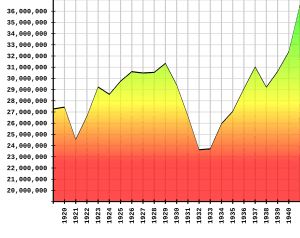
Some business leaders believed the New Deal had been bad for business. They said it caused many strikes and threatened big companies. But these problems lessened after 1938. For example, efforts to break up companies faded. Labor unions started fighting each other more than corporations. Tax policies also became more favorable for long-term growth.
Economists who supported Keynes's ideas believed the war economy showed how much government spending was needed to end the Depression. They worried that another depression would start after the war. But this didn't happen. People had saved up money during the Depression and war, and they were ready to spend it.
The End of the Depression

The U.S. government started spending a lot on its military in 1940. Millions of young men were drafted into service. By 1945, 17 million had joined the military. During the war, the government paid companies based on their costs plus a profit. This meant companies were encouraged to hire more workers.
From 1941–1943, factories hired hundreds of thousands of unskilled workers. The government paid for their training. The military also trained soldiers and sailors in technical skills. These skills helped them in the post-war economy.
Many barriers to hiring were removed during the war. Companies started hiring women, minorities, and workers over 45 or under 18. In 1941, a rule banned racial discrimination in war jobs. Unions encouraged their members to work harder. Many new factories and shipyards were built. New bus services and childcare helped people get to work. Wages increased, making it very attractive to work. All these factors pushed unemployment below 2% by 1943.
Roosevelt's popularity had dropped in 1938. Many called the economic dip the "Roosevelt Recession." In late 1938, Roosevelt tried to regain public trust. He appointed Harry Hopkins as Secretary of Commerce. This was a surprise because Hopkins had little business experience. But it was important for the years after the recession.
Hopkins worked to improve relations between Roosevelt's government and businesses. While Roosevelt believed in big New Deal reforms, Hopkins focused on recovery. He felt that recovery was most important and that too many reforms might slow it down. With support from other cabinet members, the idea of focusing on recovery, not just reform, became popular. By the end of 1938, no new reform laws were passed.
The American economy began to recover. Unemployment rates started to fall after the bad year of 1938. The biggest boost came when Germany invaded France in May 1940. After France was defeated, the U.S. economy soared. Britain and other allies needed huge amounts of war materials from the U.S.
This demand for war materials led to a massive increase in production. This created many jobs in America. Also, Britain paid for its materials in gold. This brought a lot of gold into the U.S., which boosted the money supply. This helped the American economy reach its highest point since the Depression began in 1929.
By the end of 1941, before the U.S. officially entered the war, defense spending and military buildup had created one of the biggest economic booms in American history. This ended the last signs of unemployment.
Facts and Figures
Here are some facts about the Great Depression in the U.S.:
- 13 million people lost their jobs.
- In 1932, 34 million people were in families with no regular full-time worker.
- Factory production dropped by almost 45% between 1929 and 1932.
- Home construction fell by 80% between 1929 and 1932.
- From 1929 to 1932, about 5,000 banks closed.
- By 1933, 11,000 of the 25,000 U.S. banks had failed.
- Between 1929 and 1933, U.S. GDP fell by about 30%.
- The stock market lost almost 90% of its value.
- In 1929, the average unemployment rate was 3%.
- In Cleveland, unemployment was 50%; in Toledo, Ohio, it was 80%.
- A Soviet trading company in New York received 350 job applications a day from Americans.
- Over one million families lost their farms between 1930 and 1934.
- Company profits dropped from $10 billion in 1929 to $1 billion in 1932.
- The average American family's income fell by 40% between 1929 and 1932.
- Nine million savings accounts were emptied between 1930 and 1933.
- 273,000 families were forced out of their homes in 1932.
- Two million homeless people traveled around the country.
- Over 60% of Americans were considered poor by the government in 1933.
- In 1929, nearly 280,000 immigrants came to the U.S. In 1933, only 23,068 came.
- In the early 1930s, more people left the U.S. than came to it.
- Very few new coins were made. No nickels or dimes were minted in 1932–33.
- The U.S. government encouraged a Mexican Repatriation program. Many Mexicans, including U.S. citizens, were sent to Mexico against their will. About 400,000 Mexicans were repatriated.
- Social workers in New York reported that 25% of schoolchildren were malnourished. In some mining areas, it was as high as 90%.
- Many people got sick with diseases like TB.
- The U.S. population in 1930 was about 122.7 million. About 40% were under 20 years old.
- Life expectancy increased from about 57 years in 1929 to 63 in 1933.
Images for kids


